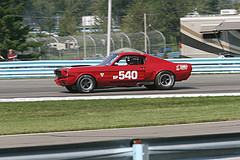The Car and Trailer/ Tow-rig
There are rental race cars available, but racing is all about your own car. Many rookies have been fixing up performance street cars for years, and assume they will just build the race care of their dreams and then find a place to race it. Nothing could be worse than doing it in that order, unless you have an unlimited budget that is. But this is about doing it right and doing it cheap. So first you need to choose a race organization, choose a class, and then build or buy a car that is legal to that specific class. Showing up for your first race weekend to find out your cool race car is NOT accepted into any class is frustrating and preventable. So do your homework first- it’s free!
To keep it cheap, your first car should be a smaller one that was mass produced. Smaller cars weigh less, so they use up less race gas, brakes, and tires (big expense items), and mass produced means there are plenty of cheap parts around. Modern examples are Miatas and RX7s, vintage examples would be 510s and Spitfires. If you’ve got to have a V8, Mustangs and Camaros are common examples in both modern and vintage flavors, but plan on much higher expenses. Most rookies come in thinking it would be cheaper to build their own first race car, but this is rarely, if ever, the truth, regardless of your fabrication skills. Buying a car already built to its class rules allows you to learn the craft of racing without the headaches and intricacies of learning the class rules. The requirements on roll cages, fire systems, restraint systems, weight limits, and allowable modifications will take you a while to get familiar with, so take advantage of someone else doing it for you. This is your first car and your first season, and you probably won’t be running up front regardless of how fast you think you are. You have a lot of other skills to learn (tuning, setup, passing and getting passed), so keep the car process as simple as possible, and it will be much cheaper in the short and long run. Try not to buy a race car that is not up and running due to a mechanical failure or not meeting current class rules. Try to see the car you’re interested in buying actually race for a day, that way you KNOW it will pass the pre-race safety and tech inspections, it is class legal, and it can finish a race without overheating or breaking down. Hundreds of racers wish they would have taken this piece of advice on their first race car!
You have to get this race car to the track. Very few race cars are street legal, so that means a trailer. Often you can buy the trailer along with the car, that way, once again, you know that it works and is legal, and it lets someone else take the depreciation hit. Bigger trailers are like bigger cars: more expensive due to weight, tires, brakes, and fuel consumption by your tow rig. An older, open, flatbed car hauler works great as a first trailer. It doesn’t give you the security or weather protection that an enclosed trailer gives you, so weigh your budget options carefully. Do NOT go cheap with your tie-down straps! They are many horror stories of cheap, old tie-down straps breaking causing your precious race car to depart it’s trailer on its way to the track. Buy good straps and take the time to use them properly.
Following our theme, Cheap and Small, there should be no surprise in what you need to tow your trailer and race car. The smaller the race car and the smaller the trailer, the smaller your tow rig will need to be. It will use less fuel, brakes, and tires as well. Hopefully this is something you already have, as many car guys already own an old pickup truck. However, if you are hauling your friends and family to the track as well, an SUV might fit the bill. If you choose a small, open trailer, a pickup truck allows you to easily bring all your track gear (tools, spare parts, canopies, chairs, coolers). If your SUV is full of people, you might need an enclosed trailer.
This is not a cheap trailer to own and operate, but it sure is a nice way to roll! Vicious guard dog costs extra…



Leave a Reply